

The Lausiac History Of Palladius - 9781542770439
CreateSpace Independent Publishing Platform
ISBN13:
9781542770439
$13.20
In the fourth and fifth centuries of our era Egypt had come to be regarded with great reverence throughout Christendom as a Holy Land of piety. Pilgrims came from all parts to visit the saints who lived there, and several wrote descriptions of what they saw and heard, which are among the most interesting documents of the early Church. Palestine was so near that it was usually included in their tour; the glamour of its sacred sites, which remains with us still when that of Egypt has faded into oblivion, was already potent. But Palestine was clearly second to Egypt in the affections of the pilgrims. The prevailing sentiment was expressed by Chrysostom with admirable clearness (Hom., in Matt. viii.). It was eminently appropriate, he explains, that the child Jesus should be taken to Egypt to escape Herod. Palestine persecutes Him, Egypt receives Him. This typifies the position Egypt was to occupy in the development of the Church. The land which had oppressed the children of Israel, had known a Pharaoh, had worshipped cats, was destined to be more fervent than any other, to have its towns and even its deserts peopled by armies of saints living the life of angels, and to boast the greatest, after the apostles, of all saints, the famous Antony. Palladius, the author of our book, who was destined to be Chrysostom's devoted adherent, made a pilgrimage to this holy land, like so many others, and stayed there many years. The following is an outline of his life, with the dates as established by Butler. He was born in Galatia in 363 or 364, and dedicated himself to the monastic life in 386 or a little later. In 388 he went to Alexandria; as Paul went up to Jerusalem to see Peter, James, and John, so, he says in the Prologue, did he go to Egypt to see the saints for himself. About 390 he passed on to Nitria, and a year later to a district in the desert known as Cellia from the multitude of its cells, where he spent nine years, first with Macarius and then with Evagrius. At the end of the time, his health having broken down, he went to Palestine in search of a cooler climate. In 400 he was consecrated bishop of Helenopolis in Bithynia, and soon became involved in the controversies which centred round St. John Chrysostom. The year 405 found him in Rome, whither he had gone to plead the cause of Chrysostom, his fidelity to whom resulted in his exile in the following year to Syene and the Thebaid, where he gained first-hand knowledge of another part of Egypt. In 412-413 he was restored, after a sojourn among the monks of the Mount of Olives. His grea.t work was written in 4I9-420 and was called the Lausiac History, being composed for Lausus, chamberlain at the court of Theodosius II. Palladius was also in all probability the author of the Dialogue on the Life of Chrysostom. He died some time in the decade 420-430.
- | Author: W K Lauther-Clarke Bn|W. Lauther-Clarke, Brother Hermenegild Tosf
- | Publisher: CreateSpace Independent Publishing Platform
- | Publication Date: Jan 27, 2017
- | Number of Pages: 188 pages
- | Language: English
- | Binding: Paperback
- | ISBN-10: 1542770432
- | ISBN-13: 9781542770439
- Author:
- W K Lauther-Clarke Bn|W. Lauther-Clarke, Brother Hermenegild Tosf
- Publisher:
- CreateSpace Independent Publishing Platform
- Publication Date:
- Jan 27, 2017
- Number of pages:
- 188 pages
- Language:
- English
- Binding:
- Paperback
- ISBN-10:
- 1542770432
- ISBN-13:
- 9781542770439



